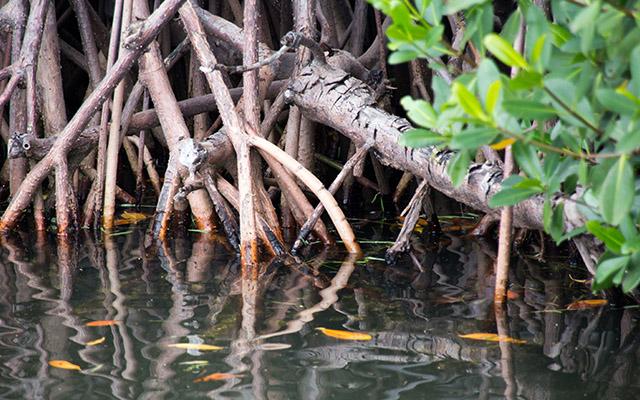Celebrating the international day for the conservation of the mangrove ecosystem, UNU-EHS Environmental Vulnerability & Ecosystem Services (EVES) division explains interesting facts about mangroves and disaster risk reduction.
Mangroves are a collection of tropical and semi-tropical trees and shrubs that grow along the seashores.
Mangrove forests can mostly be found within the tropical and subtropical regions and can consist of more than one species. They are defined by their ecological characteristics, of being able to survive the conditions of the coastal environment such as high salinity and frequent flooding.
Mangroves act as a form of defence against floods, storms, cyclones, erosion and tsunamis.
Mangroves’ roots, trunks and canopy can reduce around 60% the force of oncoming waves. Mangroves can also provide adaptive defences for sea level rise: They produce and accumulate organic matter, and trap and retain mineral sediment.
Mangroves are a good example of green infrastructure. Using nature’s solutions provide many benefits, especially in terms of sustainability and financial costs, which may outweigh those of grey (human-engineered) infrastructures, such as dams or dykes.
Mangroves support biodiversity by providing shelter, habitats, nurseries and feeding grounds for many species.
Because mangroves grow between coastal and terrestrial ecosystems, they provide a wide array of habitats. They also host a variety of species, offering nutrients to the marine food web for endangered mammals, reptiles, amphibians and birds, and providing spawning grounds for fish and shellfish.
Mangrove forests serve a critical role in climate regulation and climate change mitigation, serving as highly effective carbon storage sites.
Mangrove forests remove more carbon dioxide from the atmosphere than other forests. Offsetting carbon emissions is an essential component of climate action, as carbon dioxide leads to global warming and sea level rise. Mangroves thus have superpowers: They help remove carbon while mitigating the effects of sea level rise.
Sadly, more than a quarter of all mangrove ecosystems have been lost in the last 40 years.
A large majority of mangrove loss is due to human development. As human populations grow and expand, there is less room for mangroves to thrive. Climate change impacts, such as storms and rapid sea level rise, are additional factors that lead to reduction in mangrove forests. There is still hope, however: If we protect them, mangroves will continue to offer many benefits for humans, especially in disaster risk reduction and climate adaptation.
UNU-EHS' CLIMAFRI project includes mapping mangroves, along with other ecosystems, that are relevant to flood risk reduction in the Lower Mono River catchment in Togo and Benin.




